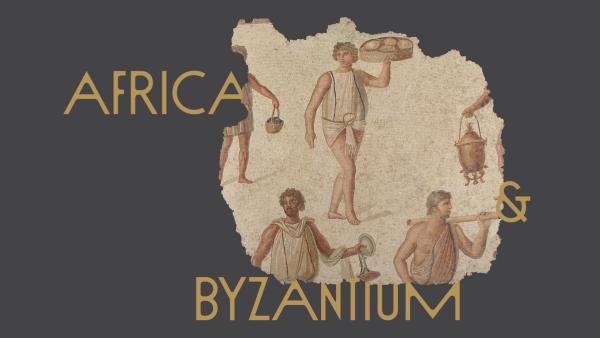Art history has long emphasized the glories of the Byzantine Empire (circa 330–1453), but less known are the profound artistic contributions of North Africa, Egypt, Nubia, Ethiopia, and other powerful African kingdoms whose pivotal interactions with Byzantium had a lasting impact on the Mediterranean world. Bringing together a range of masterworks—from mosaic, sculpture, pottery, and metalwork to luxury objects, paintings, and religious manuscripts—this exhibition recounts Africa’s central role in international networks of trade and cultural exchange. With artworks rarely or never before seen in public, Africa & Byzantium sheds new light on the staggering artistic achievements of medieval Africa. This long-overdue exhibition highlights how the continent contributed to the development of the premodern world and offers a more complete history of the vibrant multiethnic societies of north and east Africa that shaped the artistic, economic, and cultural life of Byzantium and beyond.
To access the booklet of all large-print exhibition text, click here.
The exhibition is made possible by the Ford Foundation, The Giorgi Family Foundation, and Mary Jaharis.
Major support is provided by the National Endowment for the Humanities: Democracy demands wisdom.
Additional support is provided by an Anonymous Foundation, the Michel David-Weill Fund, The International Council of The Metropolitan Museum of Art, The Visiting Committee for the Department of Medieval Art and The Cloisters, and the National Endowment for the Arts.
The exhibition is organized by The Metropolitan Museum of Art and The Cleveland Museum of Art.
The catalogue is made possible by The Giorgi Family Foundation and the Mellon Foundation.
Additional support is provided by Nellie and Robert Gipson, the National Endowment for the Humanities, Wendy A. Stein and Bart Friedman, and the Doris Duke Fund for Publications.
Any views, findings, conclusions, or recommendations expressed in this exhibition do not necessarily represent those of the National Endowment for the Humanities.
Audio Guide
Hear experts illuminate northern Africa’s key role in the Roman and Byzantine worlds.
Disponibile solo in: English
ANDREA ACHI: Welcome to this fantastic, groundbreaking exhibition, Africa & Byzantium. My name is Andrea Myers Achi, and I am the Mary and Michael Jaharis associate curator ofByzantine art. The exhibition builds upon a long legacy of Byzantine exhibitions at The Met, and it connects North Africa and the Byzantine world between the fourth to the fifteenth century. You’re going to see works from Tunisia, Ethiopia, Egypt, Sudan, spanning from mosaics, textiles, manuscripts, jewelry, and small daily life objects, as well.
NARRATOR: During this period, North Africa included some of the wealthiest, most highly educated, and cosmopolitan provinces of the late Roman and Byzantine Empire. This intricate floor mosaic fragment from the late second century once belonged to the grand dining room or reception hall of a Tunisian villa, about as large as The Met’s Great Hall.
Take a closer look at this busy scene.
ACHI: These men are preparing a feast for a festival. The first person you see is holding a breadbasket, you see four loaves of bread. And under him is a man who’s holding a wine carafe,and then someone’s holding something on his shoulders, meat or something very heavy. You also see other aspects of food and different containers.
You’re looking at men from all over North Africa and the Byzantine world. They look different because the skin is different, the hair texture is different. But it’s important to know that all of these people were Roman, and the Roman world was very diverse.
NARRATOR: Routes, over land and water, connected remote Egyptian oases to the Nile Valley and crisscrossed North Africa. They were linked by trade across the Mediterranean, sub-Saharan Africa, the Red Sea, India, and, more distantly, the Silk Roads. These routes dispersed people, materials, and ideas throughout the empire.
You’ll hear more about these rich interconnections from a variety of specialists, including members of the curatorial team, community advisors, and catalogue authors.
This audio guide is sponsored by Bloomberg Philanthropies and produced in collaboration with Acoustiguide.
Nascondi trascrizioneElenco di riproduzione
540. Welcome (Mosaic with Preparations for a Feast)
541. Curtain Fragment with Riders
542. Two Nubian Boxes
543. Four Ampullae of Saint Menas
544. “Ars Poetica”: Poem for “Spell to Acquire a Beautiful Voice”
545. Double Folio and Folio from a Qur’an
546. Vita Icon of Saint George with Scenes of his Passion and Miracles
547. Two Wall Paintings from the Cathedral at Faras in Nubia
548. Panel Painting with the Crowned Nursing Virgin and the Twelve Apostles
549. Two Healing Scrolls
550. Light Sculptures: Aberash | አበራሽ | You Give Light II and Tsehai | ፀሐይ | Sunlight
Exhibition TourJoin Dr. Andrea Myers Achi, Mary and Michael Jaharis Associate Curator of Byzantine Art in The Met’s Department of Medieval Art and The Cloisters, for a virtual tour of Africa & Byzantium.
Source link : https://www.metmuseum.org/it/exhibitions/africa-byzantium
Author :
Publish date : 2023-12-11 00:44:28
Copyright for syndicated content belongs to the linked Source.
